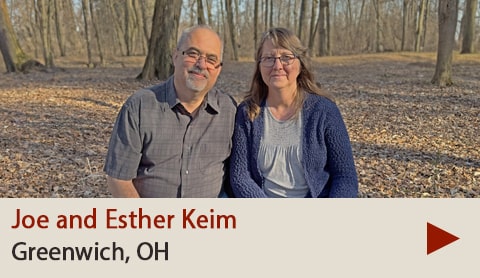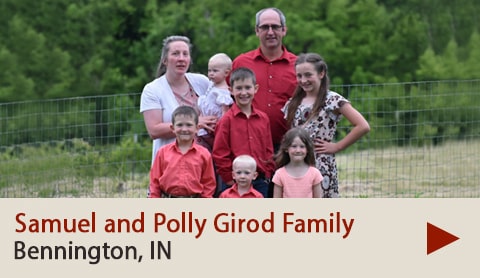History of the Amish (Part 9)
By Magda Adriana
September 1, 2024
 History of the Amish Series
History of the Amish Series
Part 1
Part 2
Part 3
Part 4
Part 5
Part 6
Part 7
Part 8
Part 9
Part 10
Part 11
The previous article showed how a new wave of Amish immigrants caused the Amish church to grow rapidly and how a more conservative and progressive-minded wing arose within the church.
Years of Division – 1850-1878
For most Americans, values like commitment to self-determination and individual freedom of choice had become almost like articles of faith. This contradicted the traditional Amish values of plainness and self-surrender for the good of the community. But if this posture placed one at odds with larger society, not all Amish agreed on what that meant for their church. Indeed, for some, the promise and prospect of American culture were attractive, and adaptation to it was welcome. They viewed change not as an exercise in wholesale assimilation but as a necessary means of remaining relevant. After 1850 especially, the tension between the push for change and the pull of tradition became acute. Increasingly, that tension resulted in conflicts that threatened to split local congregations and divide entire fellowships.
The third quarter of the nineteenth century was a time of remarkable disagreement, dissension, and schism among the Amish. While the church was still nominally united in 1850, 25 years later, controversies had produced permanent divisions. The events of those years marked subsequent Amish history, and the results, which are still visible today, underscore the lasting impact of these divisions. While these years are critical for understanding Amish history, the debate and discussion that marked them can be challenging to describe. Part of that difficulty lies in the fact that no single Amish division occurred during these years. Though there were key moments of conflict, the formation of competing parties worked its way out at different times in different places. One historian has suggested that “sorting out” would be a better way to describe the alignment of churches into change-minded and tradition-minded camps. If by 1860, for example, the Amish in northern Indiana had broken into progressive-leaning and more tradition-guided factions, the Ontario Amish did not split until the 1880s, and the church in Iowa divided only in the 1890s.
The interpretation of Ordnung often caused conflict. For some Amish, church order was something to tamper with carefully and cautiously. For others, Ordnung was a more dynamic principle that guided change and certainly did not prohibit innovations. Different views of order and change necessarily led to a division in the Amish church. With a common Ordnung as the church’s only organizational glue, disagreement on the purpose and use of Ordnung naturally led to fracture.
Dienerversammlungen
Two conservative-leaning bishops proposed that the church address the knotty questions by assembling a comprehensive gathering of Amish leaders – a Dienerversammlung (minister’s meeting) – that would address problems irritating particular communities, as well as point the direction to unity in belief and practice among North American Amish. Yet while Amish conservatives initially floated the idea, it fell to a somewhat progressive Amish deacon – eastern Lancaster County’s John Stoltzfus – to call the first minister’s conference. Stoltzfus received several letters from different parts of the country that supported him in his longing for a conference. These letters implied that such a continent-wide ministers’ meeting should become an annual event, and for 17 years, it nearly was.
The first of these comprehensive ministers’ meetings convened in June 1862 in Wayne County, Ohio, with 72 leaders in attendance. More than half were from Ohio, but participants also came from five other states. According to deacon Stoltzfus, scores of lay members—more than 4000 in 1862—also attended the sessions but did not vote or participate in discussions.
Initially, the ministers’ conferences favored the change-minded Amish agenda. The first year’s moderator, bishop Johnathan Yoder from McLean County, Illinois, and assistant moderator, bishop John Esh of Juniata County, Pennsylvania, were well-known Amish progressives. Not only did leaders affiliated with the progressive camp attend in greater numbers (about 50 of the 72 registrants could be considered change-minded), but conservative Holmes County bishop Levi Miller charged that not all the tradition-minded church districts had been informed of the meeting on purpose, and thus had been left out. Miller’s charge was only partly true; conservative David Beiler and other Lancaster County bishops and ministers, for instance, stayed away from the meeting on purpose. Although Beiler had initially suggested the ministers’ meeting, he soon sensed that it might become a vehicle for bringing more change into the church rather than creating a unified front against it.
The proceedings of the Dienerversammlungen were informal. Sessions opened with sermons, which were the highlight for many participants who otherwise had little opportunity to hear preachers from other states. Issues or problems brought to the conference received floor discussion and debate. Special committees took up important questions and formulated written responses, which they presented to the larger group. The first two annual meetings used an informal consensus method to approve or reject committee findings, but by 1864, the ministers’ meeting employed a system of majority votes. One limitation of the conference’s power was its inability to enforce decisions. Because the Amish retained local congregational authority, churches that disagreed with a particular ministers’ meeting decision could simply ignore it.
The first two meetings were somewhat successful in settling local issues. For example, it forbade using worldly musical instruments, joining state militias, holding membership in secret societies such as the Masonic Lodge, or posing for photographs. However, despite the hard line that the annual meetings took with these expressions of popular culture, many conservatives were disappointed in the tone and outcome of conference discussions and committee reports. Regarding social shunning, which had long been practiced in Amish churches, some ministers' meeting resolutions and committee reports seemed to waffle. The conferences also refused to forbid political participation. Moreover, the suggested way to bring peace in most disagreements was to ask conservatives to be more tolerant. Thus, in the end, the tension between the two wings of the Amish church was building, not lessening,.
A Breach in 1865
Before the 1865 meeting, 34 conservative-minded Amish leaders met and drew up a document that served as a type of manifesto of the tradition-minded Amish position. They took a firm stand against all they believed to be “destructive to our salvation and contrary to God’s Word.” They warned that popular attitudes and widely accepted social customs that tempted the church, in truth, “served to express pomp and pride.” Worse still, they “lead away from God.”
There was no doubting the statement's purpose; it defined the terms under which the tradition-minded Amish were willing to work. “All those who affirm such with us and demonstrate with words and deeds,” the authors announced, “we are willing to recognize as brothers and sisters and resume fellowship with them.” Though blunt and specific, the document ended with grace and invitation. Spiritual renewal – not a list of prescribed practices – was what conservatives intended their call for separation from sin to inspire.
With their position in hand, nearly all 34 signatories headed to the 1865 annual meeting in Wayne County. The conference registered the highest attendance of any, with 89 leaders present. About 40 percent of those assembled were tradition-minded Amish, the most significant representation they would ever achieve.
Curiously, the printed minutes of the 1865 meeting are the sketchiest of any of the conferences’ proceedings, so it is difficult to reconstruct the exact order of events. The ministers’ meeting took up the conservatives’ paper near the end of its business session and did little with it. While no formal response from the Holmes County conferees to the tone and agenda of that year’s larger gathering survives, it appears they were bitterly disappointed with the reception they received at the national meeting.
After 1865, only a handful of conservative Amish leaders ever attended another annual conference. Ignored out of their church, the traditionalists withdrew from the activities of the Amish majority, who were increasingly comfortable with change. (While it is impossible to say how many Amish sided with the conservatives, they eventually numbered about one-third of all districts.)
The effect the annual meetings had on the local situation was different per community and district. For example, in Lancaster County, Pennsylvania, most of the members sided with the conservatives, whereas in Central Illinois, nearly the opposite situation transpired. In other communities, there were about equal numbers of tradition-minded and change-minded Amish who slowly sorted out in the different districts.
Because the conservatives had defined their concerns in terms of a traditional understanding of the Ordnung (the “old order”), others eventually labeled them Old Order Amish. Meanwhile, many in the change-minded group had been constructing closer relations with neighboring Mennonites, many of whom had an affinity for the relatively tolerant and open Amish progressives. As a result, the Amish majority coming out of the Dienerversammlungen embraced the designation “Amish Mennonite” (not to be mistaken for the later group “Beachy Amish Mennonites”!). While these labels were not immediately or universally recognized, after the 1865 ministers’ meeting, the terms “Old Order Amish” and “Amish Mennonite” accurately pointed to two paths Amish churches chose in their interaction with the broader world. After the Wayne County ministers’ conference, the change-minded group (Amish Mennonite) and the conservatives (Old Order Amish) went separate ways.
 After the tradition-minded Amish hardly attended the Dienerversammelungen anymore, the Amish Mennonites struggled with how much change they would allow. These eventually led to two more splits: the Egly Amish, who had a more evangelical approach to conversion (demanding a personal conversion experience before baptism), and the Stuckey Amish, who had a very lenient, in the eyes of the Amish Mennonites’ too patient, view on excommunication and shunning.
After the tradition-minded Amish hardly attended the Dienerversammelungen anymore, the Amish Mennonites struggled with how much change they would allow. These eventually led to two more splits: the Egly Amish, who had a more evangelical approach to conversion (demanding a personal conversion experience before baptism), and the Stuckey Amish, who had a very lenient, in the eyes of the Amish Mennonites’ too patient, view on excommunication and shunning.
The last Dienerversammlung was held in 1878 in Woodford County, Illinois. Although the meetings did not close on a formal note, no one convened another such gathering after 1878. Perhaps the meetings ended because they no longer served a purpose. After all, the conferences were initially supposed to settle local disturbances and unify the church. But instead of unifying the Amish church, the Dienerversammlungen had tragically supported separating ways among the Amish. In the decades that followed, the gap between the groups only widened as the Old Order Amish continued to maintain a life and faith whose implications made them easily recognizable while their progressive Amish Mennonite cousins moved toward the American mainstream.
To be continued in the November issue.
Primary source: A History of the Amish, by Steven M. Nolt
« Back to Articles







